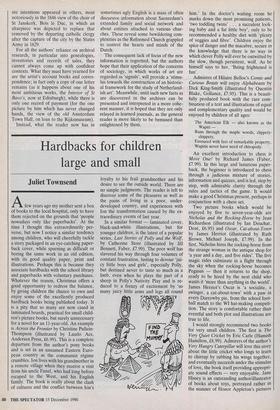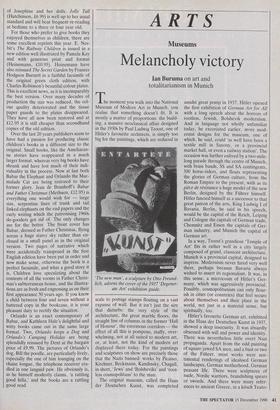Hardbacks for children large and small
Juliet Townsend
Afew years ago my mother sent a box of books to the local hospital, only to have them rejected on the grounds that 'people nowadays only like paperbacks'. At the time I thought this extraordinarily per- verse, but now I notice a similar tendency among children, who will cheerfully tackle a story packaged in an eye-catching paper- back cover, while spurning as difficult or boring the same work in an old edition, with its good quality paper, print and illustrations. Perhaps this is because they associate hardbacks with the school library and paperbacks with voluntary purchases. Whatever the reason, Christmas offers a good opportunity to redress the balance, by giving children the chance to own and enjoy some of the excellently produced hardback books being published today. It is a pity that so many are now cased in laminated boards, practical for small child- ren's picture books, but surely unnecessary for a novel for an 11-year-old. An example is Across the Frontier by Christine Pullein- Thompson (illustrated by Laszlo Acs, Andersen Press, £6.99). This is a complete departure from the author's pony books and is set in an unnamed Eastern Euro- pean country as the communist regime crumbles. Ion lives with his grandmother in a remote village when they receive a visit from his uncle Fanel, who had long before escaped to the West, and his English family. The book is really about the clash of cultures and the conflict between Ion's loyalty to his frail grandmother and his desire to see the outside world. There are no simple judgments. The reader is left to discover some of the pleasures as well as the pains of living in a poor, under- developed country, and experiences with Ion the transformation caused by the ex- traordinary events of last year.
In a similar format — laminated cover, black-and-white illustrations, but for younger children, is the latest of a popular series, Last Stories of Polly and the Wolf, by Catherine Storr (illustrated by Jill Bennett, Faber, £7.99). The poor wolf has slavered his way through four volumes of constant frustration, lusting to devour 'jui- cy little boys and girls', especially Polly, but destined never to taste so much as a limb, even when he plays the part of a sheep in Polly's Nativity Play and is re- duced to a frenzy of excitement by 'so many juicy little arms and legs all round him.' In the doctor's waiting room he marks down the most promising patients, 'two toddling twins' . . . a succulent look- ing baby and a fat little boy', only to be recommended a healthy diet with 'plenty of veggies and fibre'. Children enjoy the spice of danger and the macabre, secure in the knowledge that there is no way in which clever Polly will ever be outwitted by the slow, though persistent, wolf. As he himself says to her, 'Being frightened is fun'.
Admirers of Hilaire Belloc's Comic and Curious Beasts will enjoy Alphabeasts by Dick King-Smith (illustrated by Quentin Blake, Gollancz, £7.95). This is a beauti- fully produced book with the rare com- bination of a text and illustrations of equal and complementary quality and would be enjoyed by children of all ages:
The American Elk — also known as the Wapiti — Runs through the maple woods, clippety- cloppety, Favoured with feet of remarkable property, Wapitis never have need of chiropody.
An excellent introduction to chess is Move One. by Richard James (Faber, £7.99). In this large and luxurious paper- back, the beginner is introduced to chess through a judicious mixture of stories, information and quizzes, and is led, step by step, with admirable clarity through the rules and tactics of the game. It would make a good Christmas present, perhaps in conjunction with a chess set.
Two picture books which would be enjoyed by five to seven-year-olds are Nicholas and the Rocking-Horse by Jean Richardson (illustrated by Ian Deuchar, Dent, £6.95) and Oscar, Cat-about-Town by James Herriot (illustrated by Ruth Brown, Michael Joseph, £7.99). In the first, Nicholas hires the rocking-horse from the strange woman in the antique shop for 'a year and a day, and five rides'. The five magic rides culminate in a flight through the sky when the rocking-horse becomes Pegasus — then it returns to the shop, ready to be hired by the next child who wants it 'more than anything in the world'. James Herriot's Oscar is 'a socialite, a swinger, a cat-about-town' with a paw in every Darrowby pie, from the school foot- ball match to the WI hat-making competi- tion. The story is comfortable rather than eventful and both plot and illustrations are true to life.
I would strongly recommend two books for very small children. The first is The Very Quiet Cricket by Eric Carle (Hamish Hamilton, £8.99). Admirers of the author's Very Hungry Caterpillar will love this story about the little cricket who longs to learn to chirrup by rubbing his wings together, and eventually succeeds under the stimulus of love, the book itself providing appropri- ate sound effects — very enjoyable. Jane Hissey is an outstanding author/illustrator of books about toys, portrayed rather in the manner of Honor Appleton's pictures of Josephine and her dolls. Jolly Tall (Hutchinson, £6.99) is well up to her usual standard and will bear frequent re-reading at bedtime to a three or four year old.
For those who prefer to give books they enjoyed themselves as children, there are some excellent reprints this year. E. Nes- bit's The Railway Children is issued in a new edition well illustrated by Pamela Kay and with generous print and format (Heinemann, £10.95). Heinemann have also reissued The Secret Garden by Frances Hodgson Burnett in a faithful facsimile of the original green cloth edition, with Charles Robinson's beautiful colour plates. This is excellent news, as it is incomparably the best version. Over many decades of production the size was reduced, the col- our quality deteriorated and the tissue paper guards to the plates disappeared. They have all now been restored and at £12.95 it is still cheaper than secondhand copies of the old edition.
Over the last 20 years publishers seem to have had a passion for producing classic children's books in a different size to the original. Small books, like the Ameliaran- ne stories have reappeared in a much larger format, whereas very big books have shrunk and have lost much of their indi- viduality in the process. Now at last both Babar the Elephant and Orlando the Mar- malade Cat are being restored to their former glory. Jean de Brunhoff's Babar and Father Christmas (Methuen, £12.95) is everything one would wish for — large size, serpentine lines of trunk and tail linked elephants on the end papers and the curly writing which the patronising 1960s do-gooders got rid of. The only changes are for the better. The front cover has Babar, dressed as Father Christmas, flying across a huge starry sky rather than en- closed in a small panel as in the original version. Two pages of narrative which were accidentally transposed in the first English edition have been put in order and now make sense, otherwise the book is a perfect facsimile, and what a good story it is. Children love speculating about the contents of all the rooms in Father Christ- mas's subterranean house, and the illustra- tions are as fresh and engr.ossing as on their first appearance 50 years ago. If you know a child between four and seven without a battered copy in the bookcase, it is your pleasant duty to rectify the situation. Orlando is an exact contemporary of Babar, and Kathleen Hale's delightful and witty books came out in the same large format. Two, Orlando keeps a Dog and Orlando's Camping Holiday are being splendidly reissued by Dent at the bargain price of £9.99. The pictures of Orlando's dog, Bill the poodle, are particularly lively, especially the one of him lounging on the chaise longue, the telephone receiver cra- dled in one languid paw. He obviously is, as he himself modestly claims, 'a rattling good fella,' and the books are a rattling good read.



























































 Previous page
Previous page